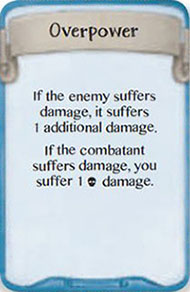
The fifth and final scenario plays very differently than the others. This cut-throat scenario pits survivors against each other in a contest to be the last one standing.
It is not really part of the main storyline, but has more replayability than the other scenarios and can be played on any terrain type.
This scenario has the following special rules:
Faceup Project Cards

At the start of the game, all project cards are placed faceup on the table. Survivors can craft any project when performing a craft action, and they never draw project cards.
If the terrain reference sheet specifies to use advanced project cards, those cards are also placed faceup on the table during setup.
Randomized Landmarks
When a survivor investigates a landmark, they do not draw the encounter card matching that landmark's number. Instead, they resolve a random #100 encounter card and place a counter in their space. Survivors cannot perform investigate actions in spaces with a counter.
Attacking other Survivors in Scenario 5
When playing scenario 5, survivors can attack other survivors, but not during the first day of the game.
A survivor can attack another survivor by spending three stamina and choosing a survivor in his or her space. The current survivor is the attaCKer and the chosen survivor is the defender. The attacker and defender are both combatants.
Combat between survivors uses the normal combat steps with the following clarifications.
-
Roll Dice: The attacker rolls the gray die and the defender rolls the red die.
-
Modify Dice: Starting with the attacker and proceeding clockwise, survivors take turns modifying dice by using their support cards, items, and resources (following normal rules).
Abilities that add to or subtract from a die without a cost are always active and do not use a survivor's turn during this step. For the purpose of abilities, each combatant treats the die he or she rolled as your roll and the other die as the eneMy roll.
Supporters cannot use items, character abilities, or spend resources to modify dice.
A survivor can pass (choose to do nothing) when it is their turn to modify dice. When all survivors pass consecutively, proceed to step 4. A survivor can pass and then choose to modify dice later during this step.
-
Deal Damage: The attacker and defender may be dealt damage based on the die results.
-
If the result of the gray die is 10 or higher, the defender is dealt one 9 (physical) damage and the attacker can take one of the defender's resources.
-
If the result of the red die is 10 or higher, the attacker is dealt one 9 (physical) damage and the defender can take one of the attacker's resources.
-
The combat ends after step 3 (there is no retreat step). Survivors can perform as many attack actions as they wish during their turn but must spend stamina each time.
Support Cards

Each other survivor within two spaces of the combatants is a supporter and may play combat support cards before rolling dice as normal. The following rules also apply.
The "Overpower" support card deals additional damage to the defender. If the attacker suffers damage, the survivor who played this card suffers one 9 (physical) damage.
Supporters cannot be dealt damage when using the "Assault" or "Defend" combat support cards.
Preventing Damage
If a survivor is dealing more than one damage and the other combatant prevents one, the additional damage is still dealt. If all damage is prevented, this does not prevent the survivor from taking one resource from the other combatant.
Continue Reading
